Assessing Soil Organic Carbon Stock Dynamics under Future Climate Change Scenarios in the Middle Qilian Mountains
Abstract
:1. Introduction
2. Materials and Methods
2.1. Study Area
2.2. Site-Level Measurements
2.3. Model Predictors
2.4. Data-Driven Model
2.5. SOC Prediction
3. Results
3.1. Future Climate and Vegetation Change Characteristics
3.2. SOC Prediction under Different Climate Change Scenarios
3.3. Elevation-Dependent SOC Dynamics in the Qilian Mountains
4. Discussion
4.1. SOC Prediction
4.2. Elevation-Dependent SOC Dynamics
4.3. Implications for SOC Management under Climate Change
5. Conclusions
Author Contributions
Funding
Data Availability Statement
Conflicts of Interest
References
- Bangroo, S.A.; Najar, G.R.; Achin, E.; Truong, P.N. Application of predictor variables in spatial quantification of soil organic carbon and total nitrogen using regression kriging in the North Kashmir forest Himalayas. Catena 2020, 193, 104632. [Google Scholar] [CrossRef]
- Chen, D.Y.; Xue, M.Y.; Duan, X.W.; Feng, D.T.; Huang, Y.; Rong, L. Changes in topsoil organic carbon from 1986 to 2010 in a mountainous plateau region in Southwest China. Land Degrad. Develop. 2019, 31, 734–747. [Google Scholar] [CrossRef]
- Pepin, N.; Bradley, R.S.; Diaz, H.F.; Baraer, M.; Caceres, E.B.; Forsythe, N.; Fowler, H.; Greenwood, G.; Hashmi, M.Z.; Liu, X.D.; et al. Elevation-dependent warming in mountain regions of the world. Nat. Clim. Chang. 2015, 5, 424–430. [Google Scholar] [CrossRef] [Green Version]
- Chen, L.Y.; Smith, P.; Yang, Y.H. How has soil carbon stock changed over recent decades? Glob. Chang. Biol. 2015, 21, 3197–3199. [Google Scholar] [CrossRef]
- Ding, J.Z.; Li, F.; Yang, G.B.; Chen, L.Y.; Zhang, B.B.; Liu, L.; Fang, K.; Qin, S.Q.; Chen, Y.L.; Peng, Y.F.; et al. The permafrost carbon inventory on the Tibetan Plateau: A new evaluation using deep sediment cores. Glob. Chang. Biol. 2016, 22, 2688–2701. [Google Scholar] [CrossRef]
- Stockmann, U.; Adams, M.A.; Crawford, J.W.; Field, D.J.; Henakaarchchi, N.; Jenkins, M.; Minasny, B.; McBratney, A.B.; de Courcelles, V.D.R.; Singh, K.; et al. The knowns, known unknowns and unknowns of sequestration of soil organic carbon. Agric. Ecosyst. Environ. 2013, 164, 80–99. [Google Scholar] [CrossRef]
- Bangroo, S.A.; Najar, G.R.; Rasool, A. Effect of altitude and aspect on soil organic carbon and nitrogen stocks in the Himalayan Mawer Forest Range. Catena 2017, 158, 63–68. [Google Scholar] [CrossRef]
- Chen, L.F.; He, Z.B.; Du, J.; Yang, J.J.; Zhu, X. Patterns and environmental controls of soil organic carbon and total nitrogen in alpine ecosystems of northwestern China. Catena 2016, 137, 37–43. [Google Scholar] [CrossRef]
- Bellamy, P.H.; Loveland, P.J.; Bradley, R.I.; Lark, R.M.; Kirk, G.J.D. Carbon losses from all soils across England and Wales 1978–2003. Nature 2005, 437, 245–248. [Google Scholar] [CrossRef] [PubMed] [Green Version]
- Melillo, J.M.; Frey, S.D.; DeAngelis, K.M.; Werner, W.J.; Bernard, M.J.; Bowles, F.P.; Pold, G.; Knorr, M.A.; Grandy, A.S. Long-term pattern and magnitude of soil carbon feedback to the climate system in a warming world. Science 2017, 358, 101–104. [Google Scholar] [CrossRef] [Green Version]
- Wang, S.; Xu, L.; Zhuang, Q.L.; He, N.P. Investigating the spatio-temporal variability of soil organic carbon stocks in different ecosystems of China. Sci. Total Environ. 2021, 758, 143644. [Google Scholar] [CrossRef] [PubMed]
- Hong, S.B.; Yin, G.D.; Piao, S.L.; Dybzinski, R.; Cong, N.; Li, X.Y.; Wang, K.; Penuelas, J.; Zeng, H.; Chen, A.P. Divergent responses of soil organic carbon to afforestation. Nat. Sustain. 2020, 3, 694–700. [Google Scholar] [CrossRef]
- Zhu, M.; Feng, Q.; Zhang, M.X.; Liu, W.; Deo, R.C.; Zhang, C.Q.; Yang, L.S. Soil organic carbon in semiarid alpine regions: The spatial distribution, stock estimation, and environmental controls. J. Soils Sediments 2019, 19, 3427–3441. [Google Scholar] [CrossRef]
- Gray, J.M.; Bishop, T.F.A. Change in soil organic carbon stocks under 12 climate change projections over New South Wales, Australia. Soil Sci. Soc. Am. J. 2016, 80, 1296–1307. [Google Scholar] [CrossRef] [Green Version]
- Luo, Y.Q.; Ahlstrom, A.; Allison, S.D.; Batjes, N.H.; Brovkin, V.; Carvalhais, N.; Chappell, A.; Ciais, P.; Davidson, E.A.; Finzi, A.C.; et al. Toward more realistic projections of soil carbon dynamics by Earth system models. Glob. Biogeochem. Cycles 2016, 30, 40–56. [Google Scholar] [CrossRef]
- Caddeo, A.; Marras, S.; Sallustio, L.; Spano, D.; Sirca, C. Soil organic carbon in Italian forests and agroecosystems: Estimating current stock and future changes with a spatial modelling approach. Agric. For. Meteorol. 2019, 278, 107654. [Google Scholar] [CrossRef]
- Luo, Z.K.; Eady, S.; Sharma, B.; Grant, T.; Liu, D.L.; Cowie, A.; Farquharson, R.; Simmons, A.; Crawford, D.; Searle, R.; et al. Mapping future soil carbon change and its uncertainty in croplands using simple surrogates of a complex farming system model. Geoderma 2019, 337, 311–321. [Google Scholar] [CrossRef]
- Todd-Brown, K.E.O.; Randerson, J.T.; Hopkins, F.; Arora, V.; Hajima, T.; Jones, C.; Shevliakova, E.; Tjiputra, J.; Volodin, E.; Wu, T.; et al. Changes in soil organic carbon storage predicted by Earth system models during the 21st century. Biogeosciences 2014, 11, 2341–2356. [Google Scholar] [CrossRef] [Green Version]
- McBratney, A.B.; Santos, M.L.M.; Minasny, B. On digital soil mapping. Geoderma 2003, 117, 3–52. [Google Scholar] [CrossRef]
- Wang, S.; Zhuang, Q.L.; Yang, Z.J.; Yu, N.; Jin, X.X. Temporal and spatial changes of soil organic carbon stocks in the forest area of northeastern China. Forests 2019, 10, 1023. [Google Scholar] [CrossRef] [Green Version]
- Huang, J.Y.; Hartemink, A.E.; Zhang, Y.K. Climate and land-use change effects on soil carbon stocks over 150 Years in Wisconsin, USA. Remote Sens. 2019, 11, 1504. [Google Scholar] [CrossRef] [Green Version]
- Li, H.W.; Wu, Y.P.; Chen, J.; Zhao, F.B.; Wang, F.; Sun, Y.Z.; Zhang, G.C.; Qiu, L.J. Responses of soil organic carbon to climate change in the Qilian Mountains and its future projection. J. Hydrol. 2021, 596, 126110. [Google Scholar] [CrossRef]
- Wadoux, A.M.J.C.; Minasny, B.; McBratney, A.B. Machine learning for digital soil mapping: Applications, challenges and suggested solutions. Earth-Sci. Rev. 2020, 210, 103359. [Google Scholar] [CrossRef]
- Adhikari, K.; Owens, P.R.; Libohova, Z.; Miller, D.M.; Wills, S.A.; Nemecek, J. Assessing soil organic carbon stock of Wisconsin, USA and its fate under future land use and climate change. Sci. Total Environ. 2019, 667, 833–845. [Google Scholar] [CrossRef] [PubMed]
- Bonfatti, B.R.; Hartemink, A.E.; Giasson, E.; Tornquist, C.G.; Adhikari, K. Digital mapping of soil carbon in a viticultural region of Southern Brazil. Geoderma 2016, 261, 204–221. [Google Scholar] [CrossRef]
- Feng, Q.; Yang, L.S.; Deo, R.C.; AghaKouchak, A.; Adamowski, J.F.; Stone, R.; Yin, Z.L.; Liu, W.; Si, J.H.; Wen, X.H.; et al. Domino effect of climate change over two millennia in ancient China’s Hexi Corridor. Nat. Sustain. 2019, 2, 957–961. [Google Scholar] [CrossRef]
- Yang, L.S.; Feng, Q.; Adamowski, J.F.; Alizadeh, M.R.; Yin, Z.L.; Wen, X.H.; Zhu, M. The role of climate change and vegetation greening on the variation of terrestrial evapotranspiration in northwest China’s Qilian Mountains. Sci. Total Environ. 2021, 759, 143532. [Google Scholar] [CrossRef]
- Zhu, M.; Feng, Q.; Qin, Y.Y.; Cao, J.J.; Zhang, M.X.; Liu, W.; Deo, R.C.; Zhang, C.Q.; Li, R.L.; Li, B.F. The role of topography in shaping the spatial patterns of soil organic carbon. Catena 2019, 176, 296–305. [Google Scholar] [CrossRef]
- Liu, W.; Li, Z.X.; Zhu, M.; Guo, X.Y.; Chen, L.J. Temperature and precipitation changes in Extensive Hexi Region, China, 1960–2011. Sci. Cold Arid Reg. 2016, 8, 212–226. [Google Scholar] [CrossRef]
- Zhu, M.; Feng, Q.; Qin, Y.Y.; Cao, J.J.; Li, H.Y.; Zhao, Y. Soil organic carbon as functions of slope aspects and soil depths in a semiarid alpine region of Northwest China. Catena 2017, 152, 94–102. [Google Scholar] [CrossRef]
- Chen, L.H.; Qu, Y.G.; Chen, H.S.; Li, F.X. Water and Land Resources and Their Rational Development and Utilizationin the Hexi Region; Science Press: Beijing, China, 1992. (In Chinese) [Google Scholar]
- IUSS Working Group WRB. World Reference Base for Soil Resources 2014, Update 2015 International Soil Classification System for Naming Soils and Creating Legends for Soil Maps; World Soil Resources Reports, No. 106; FAO: Rome, Italy, 2015. [Google Scholar]
- Li, Z.X.; Feng, Q.; Li, Z.J.; Wang, X.F.; Gui, J.; Zhang, B.J.; Li, Y.C.; Deng, X.H.; Xue, J.; Gao, W.D.; et al. Reversing conflict between humans and the environment—The experience in the Qilian Mountains. Renew. Sustain. Energy Rev. 2021, 148, 111333. [Google Scholar] [CrossRef]
- Song, X.D.; Brus, D.J.; Liu, F.; Li, D.C.; Zhao, Y.G.; Yang, J.L.; Zhang, G.L. Mapping soil organic carbon content by geographically weighted regression: A case study in the Heihe River Basin, China. Geoderma 2016, 261, 11–22. [Google Scholar] [CrossRef]
- Wu, T.W.; Lu, Y.X.; Fang, Y.J.; Xin, X.G.; Li, L.; Li, W.P.; Jie, W.H.; Zhang, J.; Liu, Y.M.; Zhang, L.; et al. The Beijing Climate Center Climate System Model (BCC-CSM): The main progress from CMIP5 to CMIP6. Geosci. Model Dev. 2019, 12, 1573–1600. [Google Scholar] [CrossRef] [Green Version]
- Bentsen, M.; Bethke, I.; Debernard, J.B.; Iversen, T.; Kirkevag, A.; Seland, O.; Drange, H.; Roelandt, C.; Seierstad, I.A.; Hoose, C.; et al. The Norwegian Earth System Model, NorESM1-M—Part 1: Description and basic evaluation of the physical climate. Geosci. Model Dev. 2013, 6, 687–720. [Google Scholar] [CrossRef] [Green Version]
- Iversen, T.; Bentsen, M.; Bethke, I.; Debernard, J.B.; Kirkevag, A.; Seland, O.; Drange, H.; Kristjansson, J.E.; Medhaug, I.; Sand, M.; et al. The Norwegian Earth System Model, NorESM1-M—Part 2: Climate response and scenario projections. Geosci. Model Dev. 2013, 6, 389–415. [Google Scholar] [CrossRef] [Green Version]
- Jones, C.D.; Hughes, J.K.; Bellouin, N.; Hardiman, S.C.; Jones, G.S.; Knight, J.; Liddicoat, S.; O’Connor, F.M.; Andres, R.J.; Bell, C.; et al. The HadGEM2-ES implementation of CMIP5 centennial simulations. Geosci. Model Dev. 2011, 4, 543–570. [Google Scholar] [CrossRef] [Green Version]
- Dufresne, J.L.; Foujols, M.A.; Denvil, S.; Caubel, A.; Marti, O.; Aumont, O.; Balkanski, Y.; Bekki, S.; Bellenger, H.; Benshila, R.; et al. Climate change projections using the IPSL-CM5 Earth System Model: From CMIP3 to CMIP5. Clim. Dyn. 2013, 40, 2123–2165. [Google Scholar] [CrossRef]
- Schmidt, G.A.; Kelley, M.; Nazarenko, L.; Ruedy, R.; Russell, G.L.; Aleinov, I.; Bauer, M.; Bauer, S.E.; Bhat, M.K.; Bleck, R.; et al. Configuration and assessment of the GISS ModelE2 contributions to the CMIP5 archive. J. Adv. Model. Earth Syst. 2014, 6, 141–184. [Google Scholar] [CrossRef]
- Breiman, L. Random forests. Mach. Learn. 2001, 45, 5–32. [Google Scholar] [CrossRef] [Green Version]
- Yang, R.M.; Zhang, G.L.; Liu, F.; Lu, Y.Y.; Yang, F.; Yang, F.; Yang, M.; Zhao, Y.G.; Li, D.C. Comparison of boosted regression tree and random forest models for mapping topsoil organic carbon concentration in an alpine ecosystem. Ecol. Indic. 2016, 60, 870–878. [Google Scholar] [CrossRef]
- Zhao, C.Y.; Nan, Z.R.; Cheng, G.D. Methods for modelling of temporal and spatial distribution of air temperature at landscape scale in the southern Qilian Mountains, China. Ecol. Model. 2005, 189, 209–220. [Google Scholar] [CrossRef]
- Zhao, C.Y.; Nan, Z.R.; Cheng, G.D.; Zhang, J.H.; Feng, Z.D. GIS-assisted modelling of the spatial distribution of Qinghai spruce (Picea crassifolia) in the Qilian Mountains, northwestern China based on biophysical parameters. Ecol. Model. 2006, 191, 487–500. [Google Scholar] [CrossRef]
- Adhikari, K.; Hartemink, A.E.; Minasny, B.; Kheir, R.B.; Greve, M.B.; Greve, M.H. Digital mapping of soil organic carbon contents and stocks in Denmark. PLoS ONE 2014, 9, e105519. [Google Scholar] [CrossRef]
- Mulder, V.L.; Lacoste, M.; Richer-de-Forges, A.C.; Martin, M.P.; Arrouays, D. National versus global modelling the 3D distribution of soil organic carbon in mainland France. Geoderma 2016, 263, 16–34. [Google Scholar] [CrossRef]
- Soleimani, A.; Hosseini, S.M.; Bavani, A.R.M.; Jafari, M.; Francaviglia, R. Simulating soil organic carbon stock as affected by land cover change and climate change, Hyrcanian forests (northern Iran). Sci. Total Environ. 2017, 599, 1646–1657. [Google Scholar] [CrossRef]
- Yang, L.S.; Feng, Q.; Yin, Z.L.; Wen, X.H.; Si, J.H.; Li, C.B.; Deo, C.R. Identifying separate impacts of climate and land use/cover change on hydrological processes in upper stream of Heihe River, Northwest China. Hydrol. Process. 2017, 31, 1100–1112. [Google Scholar] [CrossRef]
- Wiesmeier, M.; Urbanski, L.; Hobley, E.; Lang, B.; von Luetzow, M.; Marin-Spiotta, E.; van Wesemael, B.; Rabot, E.; Liess, M.; Garcia-Franco, N.; et al. Soil organic carbon storage as a key function of soils—A review of drivers and indicators at various scales. Geoderma 2019, 333, 149–162. [Google Scholar] [CrossRef]
- Prietzel, J.; Zimmermann, L.; Schubert, A.; Christophel, D. Organic matter losses in German Alps forest soils since the 1970s most likely caused by warming. Nat. Geosci. 2016, 9, 543–550. [Google Scholar] [CrossRef]
- Ding, J.Z.; Chen, L.Y.; Ji, C.J.; Hugelius, G.; Li, Y.N.; Liu, L.; Qin, S.Q.; Zhang, B.B.; Yang, G.B.; Li, F.; et al. Decadal soil carbon accumulation across Tibetan permafrost regions. Nat. Geosci. 2017, 10, 420–424. [Google Scholar] [CrossRef] [Green Version]
- Jakšić, S.; Ninkov, J.; Milić, S.; Vasin, J.; Zivanov, M.; Jaksic, D.; Komlen, V. Influence of slope gradient and aspect on soil organic carbon content in the region of Nis, Serbia. Sustainability 2021, 13, 8332. [Google Scholar] [CrossRef]
- Yang, Y.H.; Mohammat, A.; Feng, J.M.; Zhou, R.; Fang, J.Y. Storage, patterns and environmental controls of soil organic carbon in China. Biogeochemistry 2007, 84, 131–141. [Google Scholar] [CrossRef]
- Crowther, T.W.; Todd-Brown, K.E.O.; Rowe, C.W.; Wieder, W.R.; Carey, J.C.; Machmuller, M.B.; Snoek, B.L.; Fang, S.; Zhou, G.; Allison, S.D.; et al. Quantifying global soil carbon losses in response to warming. Nature 2016, 540, 104–108. [Google Scholar] [CrossRef] [PubMed]
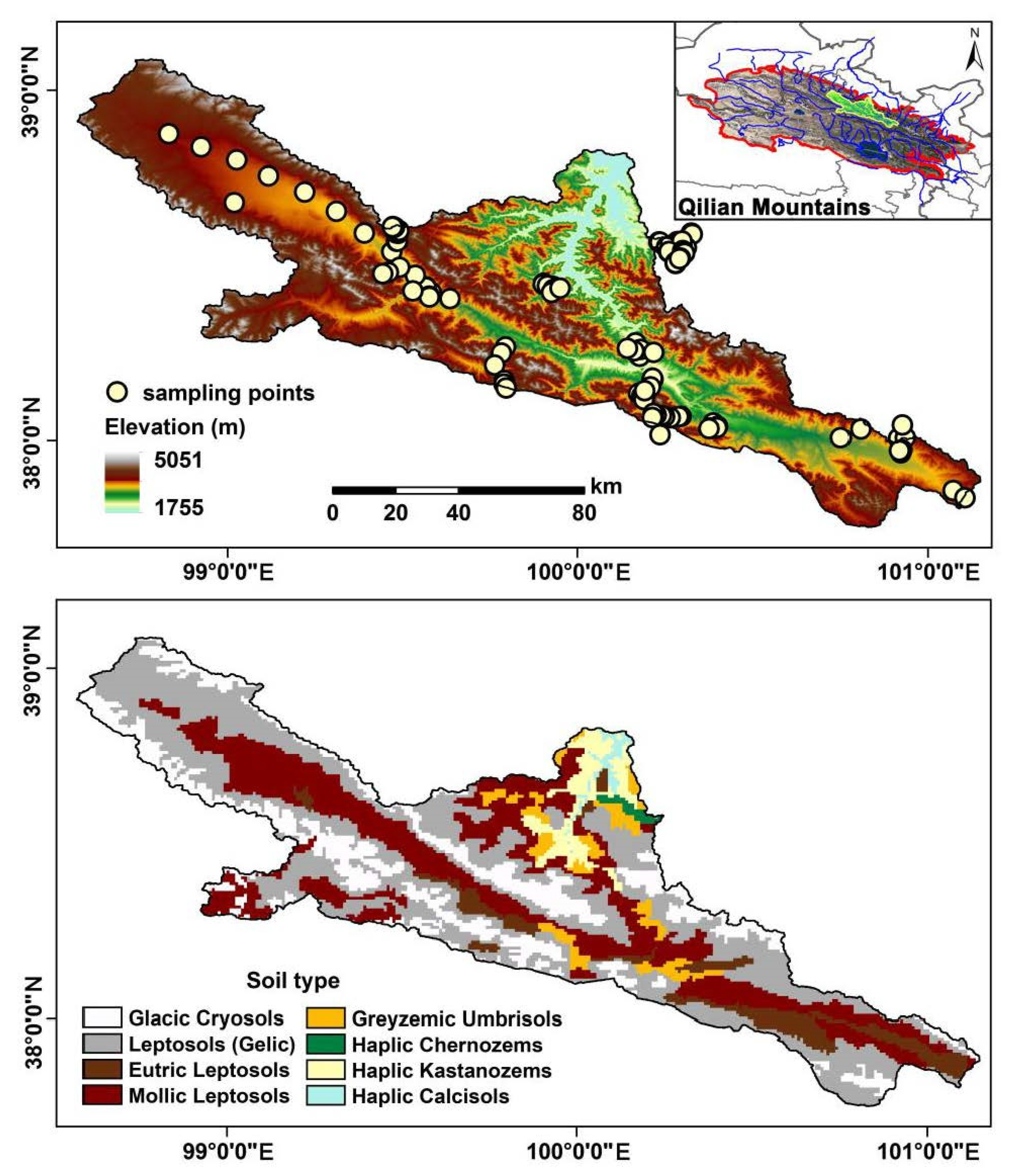

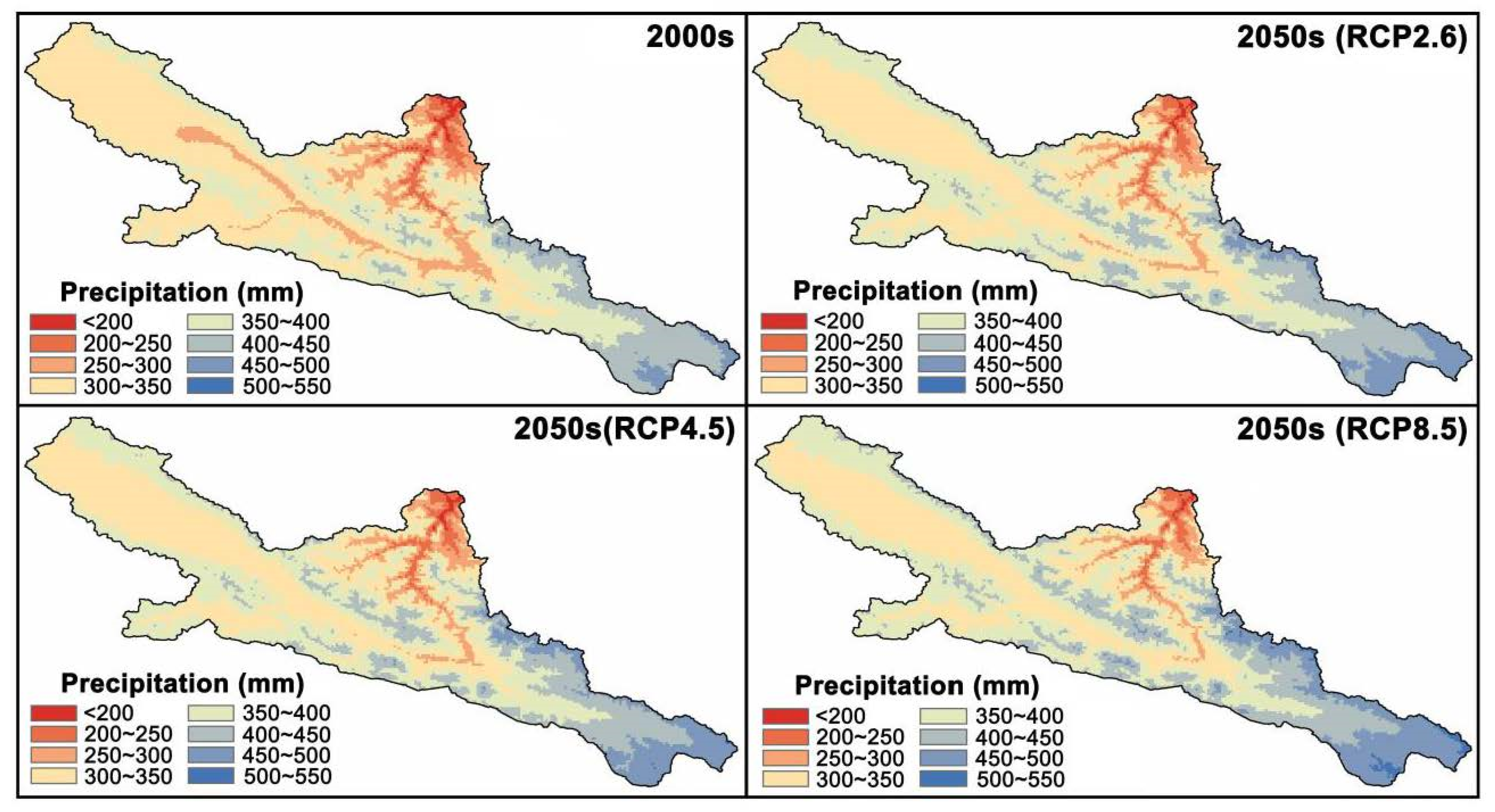

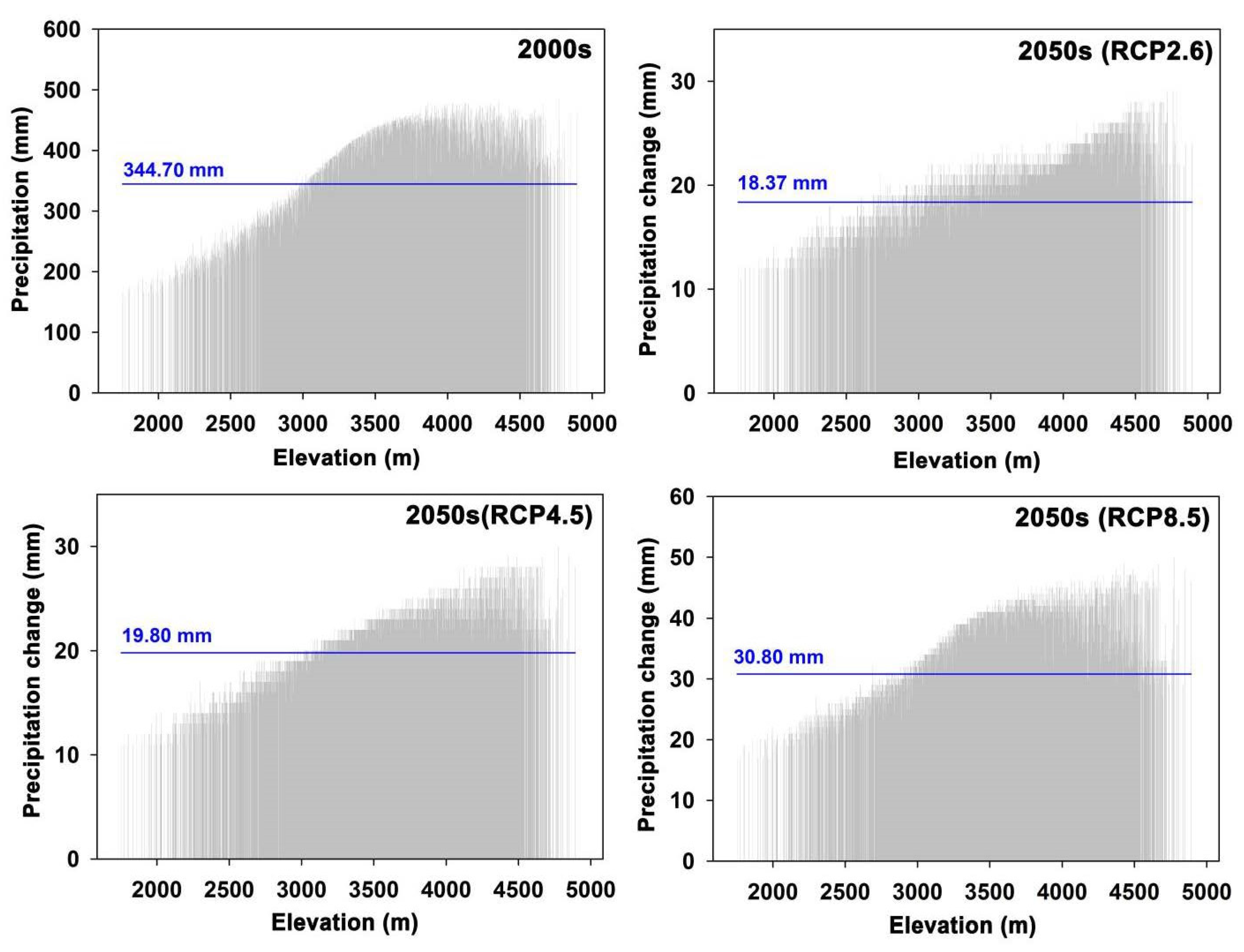

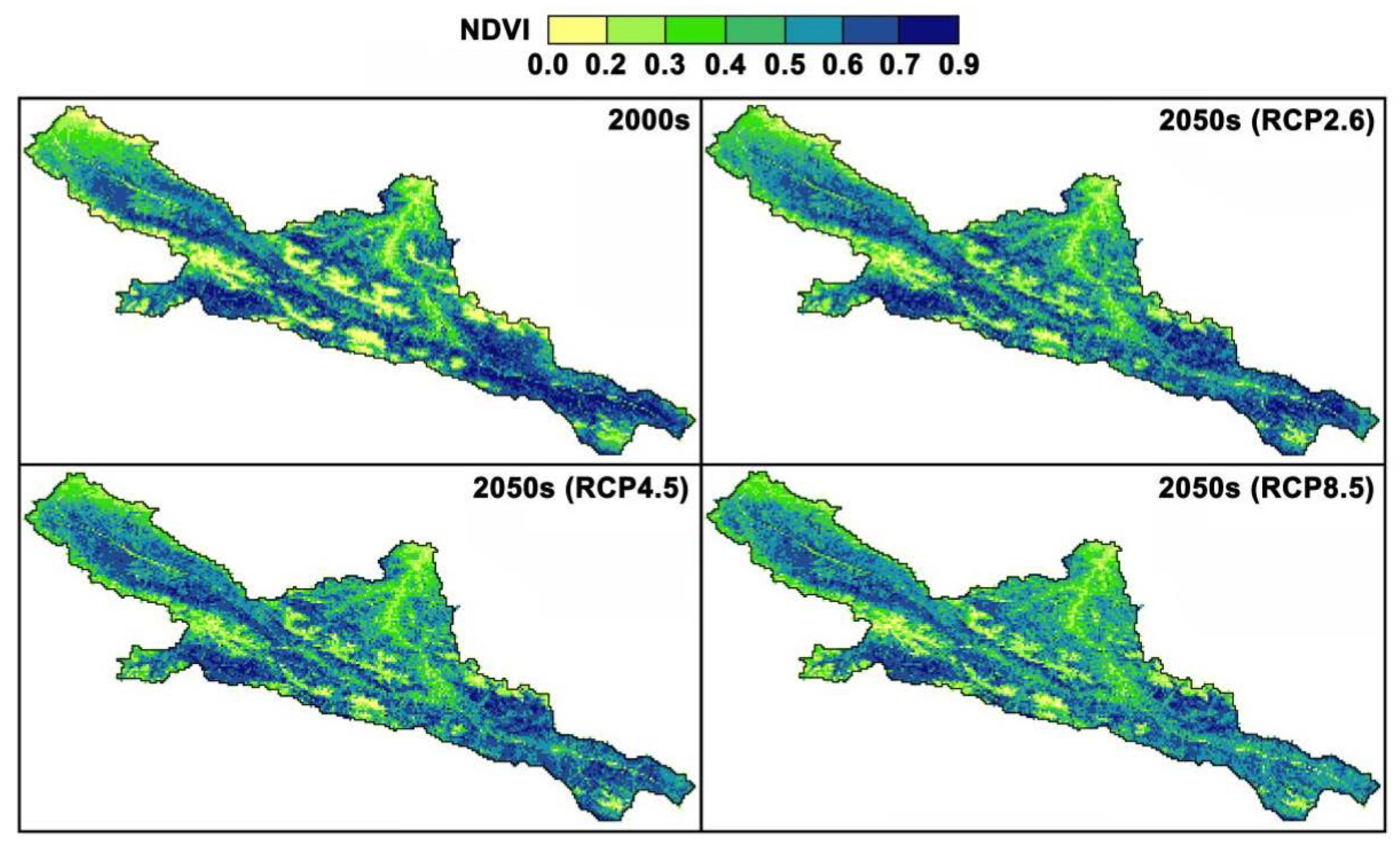

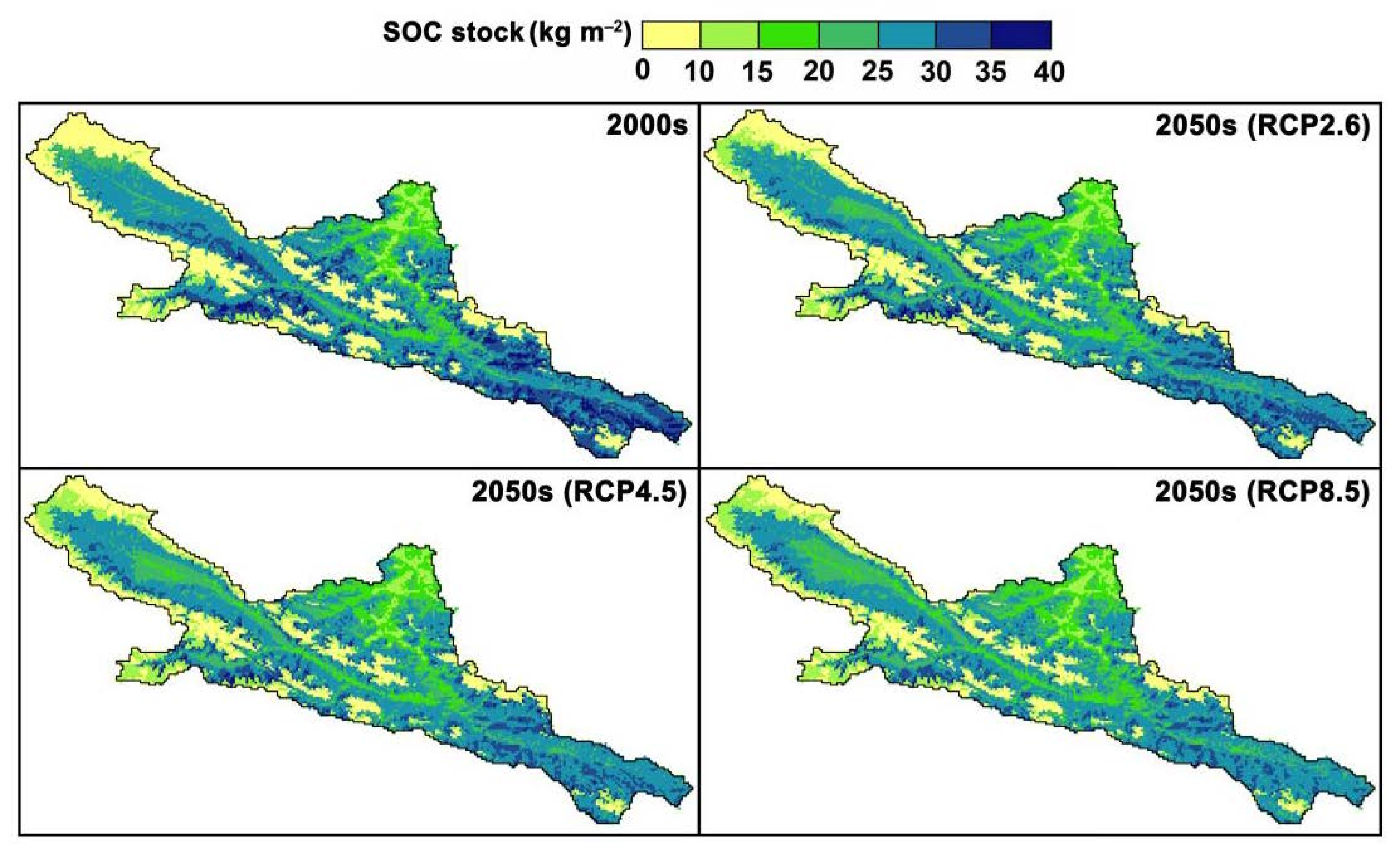

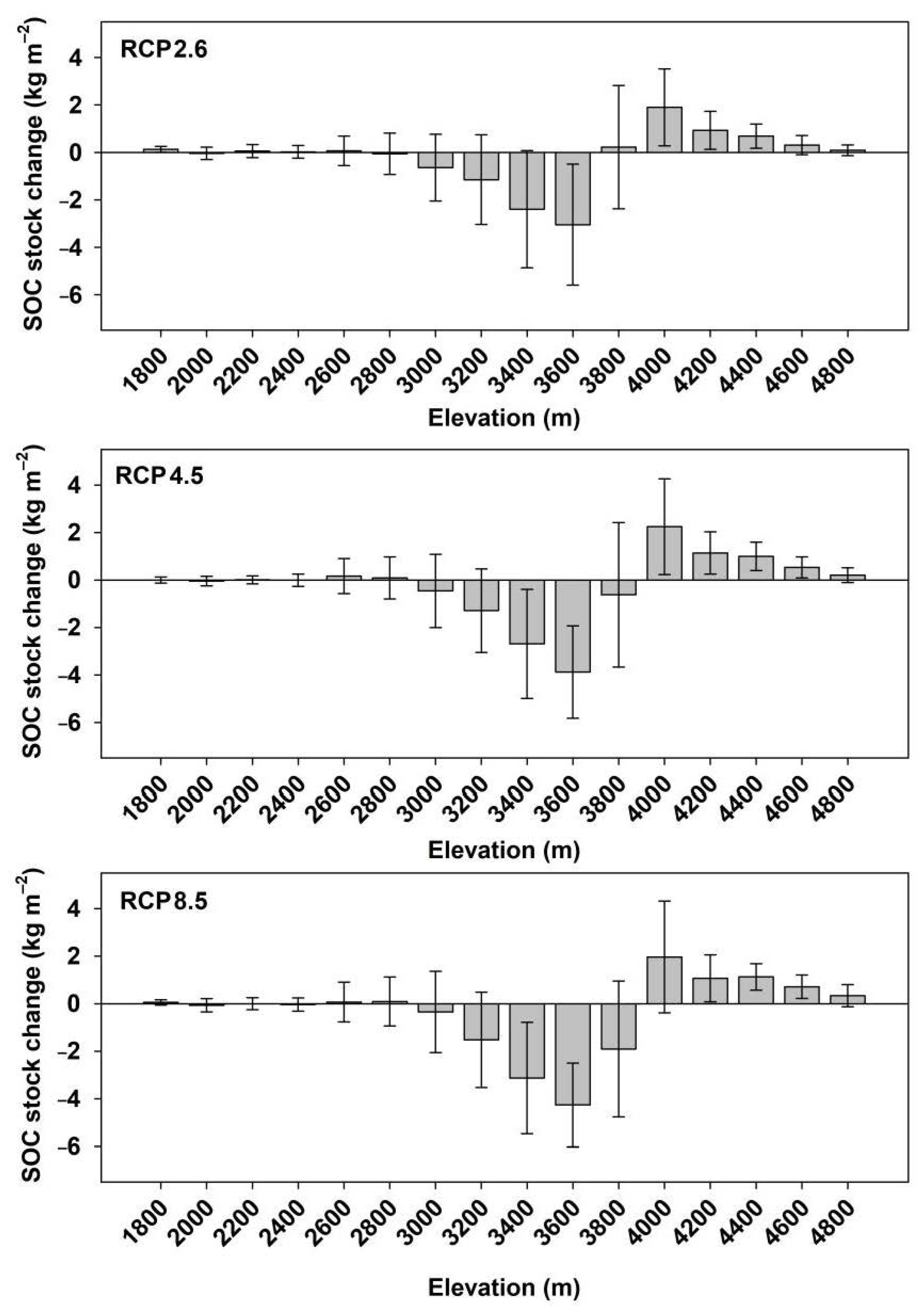
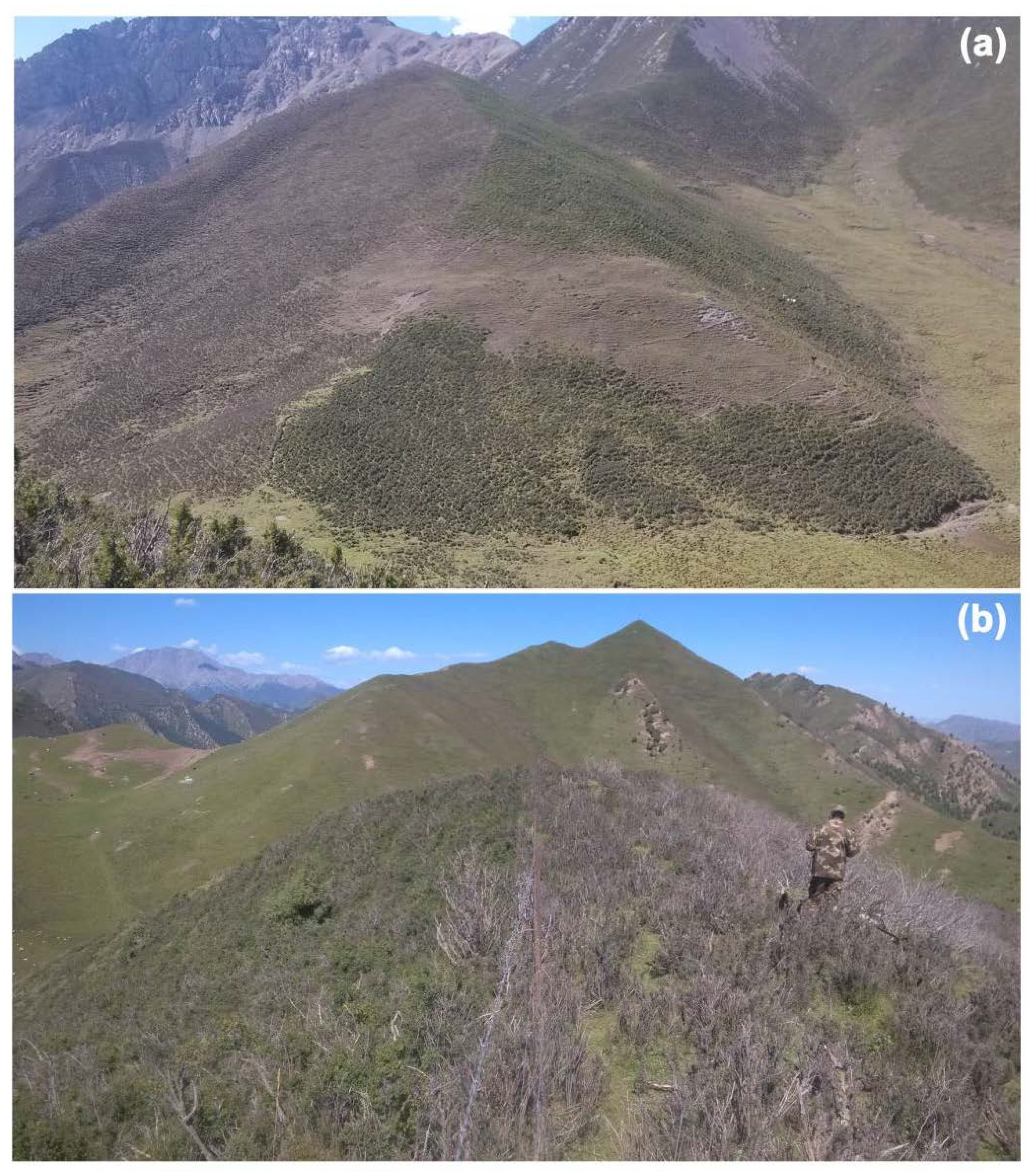
| Vegetation Type | Area (km2) | Change in Area (km2) | ||
|---|---|---|---|---|
| 2000s | 2050s (RCP2.6) | 2050s (RCP4.5) | 2050s (RCP8.5) | |
| Montane desert steppe | 101 | −10 | −15 | −24 |
| Montane steppe | 745 | 13 | 12 | 18 |
| Montane meadow steppe | 267 | −29 | −18 | −34 |
| Montane shrub | 447 | 40 | 37 | 56 |
| Montane forest | 776 | 32 | 63 | 100 |
| Subalpine meadow | 1564 | 199 | 216 | 250 |
| Subalpine shrub | 1002 | −63 | −37 | 234 |
| Alpine meadow | 3676 | −124 | −185 | −577 |
| Alpine desert | 1875 | −57 | −72 | −22 |
| No vegetation | 46 | 0 | 0 | 0 |
| Statistics | Minimum | 1st Quartile | Median | Mean | 3rd Quartile | Maximum | Standard Deviation |
|---|---|---|---|---|---|---|---|
| R2 | 0.73 | 0.77 | 0.78 | 0.78 | 0.80 | 0.82 | 0.02 |
| RMSE | 4.70 | 5.00 | 5.06 | 5.10 | 5.26 | 5.50 | 0.19 |
| Vegetation Types | SOC Stock (kg m−2) | SOC Stock Changes (kg m−2) | ||
|---|---|---|---|---|
| 2000s | RCP2.6 | RCP4.5 | RCP8.5 | |
| Montane desert steppe | 14.89 | 0.06 | 0.00 | −0.01 |
| Montane steppe | 19.62 | −0.40 | −0.35 | −0.39 |
| Montane meadow steppe | 25.61 | −0.69 | −0.64 | −0.61 |
| Montane shrub | 24.72 | −0.89 | −0.71 | −0.96 |
| Montane forest | 24.99 | −0.93 | −1.10 | −1.26 |
| Subalpine meadow | 28.21 | −2.85 | −3.24 | −3.64 |
| Subalpine shrub | 31.37 | −2.46 | −3.04 | −3.30 |
| Alpine meadow | 23.91 | 0.87 | 0.57 | 0.08 |
| Alpine desert | 8.45 | 0.73 | 0.96 | 1.00 |
| No vegetation | 16.73 | 0.15 | 0.01 | −0.29 |
| Total | 22.23 | −0.43 | −0.63 | −1.01 |
| Vegetation Types | Area (km2) | SOC Storage (Tg) | SOC Storage Changes (Tg) | |||||
|---|---|---|---|---|---|---|---|---|
| 2000s | RCP2.6 | RCP4.5 | RCP8.5 | 2000s | RCP2.6 | RCP4.5 | RCP8.5 | |
| Montane desert steppe | 101.14 | 90.65 | 86.16 | 77.17 | 1.51 | 0.01 | 0.00 | 0.00 |
| Montane steppe | 745.45 | 758.19 | 757.44 | 762.68 | 14.63 | −0.30 | −0.26 | −0.30 |
| Montane meadow steppe | 267.46 | 238.24 | 248.73 | 233.00 | 6.85 | −0.17 | −0.16 | −0.14 |
| Montane shrub | 446.52 | 486.98 | 483.98 | 503.46 | 11.04 | −0.43 | −0.35 | −0.48 |
| Montane forest | 776.17 | 807.63 | 839.10 | 875.81 | 19.40 | −0.75 | −0.93 | −1.11 |
| Subalpine meadow | 1563.57 | 1762.86 | 1780.09 | 1813.81 | 44.11 | −5.03 | −5.76 | −6.60 |
| Subalpine shrub | 1001.68 | 939.49 | 964.97 | 1236.18 | 31.42 | −2.31 | −2.93 | −4.08 |
| Alpine meadow | 3676.31 | 3551.94 | 3491.26 | 3099.43 | 87.90 | 3.11 | 2.00 | 0.25 |
| Alpine desert | 1875.24 | 1817.55 | 1802.57 | 1852.76 | 15.84 | 1.32 | 1.72 | 1.86 |
| No vegetation | 46.45 | 46.45 | 45.70 | 45.70 | 0.78 | 0.01 | 0.00 | −0.01 |
| Total | 10,500.00 | 10,500.00 | 10,500.00 | 10,500.00 | 233.46 | −4.55 | −6.66 | −10.62 |
| Vegetation Types | Area (km2) | SOC (2000s) | SOC Changes (RCP2.6) | SOC Changes (RCP4.5) | SOC Changes (RCP8.5) | ||||
|---|---|---|---|---|---|---|---|---|---|
| Stock (kg m−2) | Storage (Tg) | Stock (kg m−2) | Storage (Tg) | Stock (kg m−2) | Storage (Tg) | Stock (kg m−2) | Storage (Tg) | ||
| Glacic Cryosols | 1923.19 | 12.45 | 23.94 | 0.83 | 1.60 | 0.95 | 1.83 | 0.84 | 1.62 |
| Leptosols (Gelic) | 4083.13 | 23.89 | 97.54 | −0.11 | −0.44 | −0.33 | −1.35 | −0.85 | −3.48 |
| Eutric Leptosols | 685.52 | 29.38 | 20.14 | −1.70 | −1.16 | −1.96 | −1.35 | −2.38 | −1.63 |
| Mollic Leptosols | 2827.47 | 25.71 | 72.69 | −1.47 | −4.15 | −1.89 | −5.33 | −2.37 | −6.71 |
| Greyzemic Umbrisols | 433.04 | 24.81 | 10.75 | −0.80 | −0.35 | −0.82 | −0.36 | −0.83 | −0.36 |
| Haplic Chernozems | 53.94 | 20.21 | 1.09 | 0.00 | 0.00 | 0.05 | 0.00 | 0.00 | 0.00 |
| Haplic Kastanozems | 403.82 | 14.89 | 6.01 | −0.15 | −0.06 | −0.27 | −0.11 | −0.16 | −0.07 |
| Haplic Calcisols | 89.90 | 14.57 | 1.31 | 0.06 | 0.01 | 0.00 | 0.00 | 0.00 | 0.00 |
| Total | 10,500.00 | 22.23 | 233.46 | −0.43 | −4.55 | −0.63 | −6.66 | −1.01 | −10.62 |
Publisher’s Note: MDPI stays neutral with regard to jurisdictional claims in published maps and institutional affiliations. |
© 2021 by the authors. Licensee MDPI, Basel, Switzerland. This article is an open access article distributed under the terms and conditions of the Creative Commons Attribution (CC BY) license (https://creativecommons.org/licenses/by/4.0/).
Share and Cite
Liu, W.; Zhu, M.; Li, Y.; Zhang, J.; Yang, L.; Zhang, C. Assessing Soil Organic Carbon Stock Dynamics under Future Climate Change Scenarios in the Middle Qilian Mountains. Forests 2021, 12, 1698. https://doi.org/10.3390/f12121698
Liu W, Zhu M, Li Y, Zhang J, Yang L, Zhang C. Assessing Soil Organic Carbon Stock Dynamics under Future Climate Change Scenarios in the Middle Qilian Mountains. Forests. 2021; 12(12):1698. https://doi.org/10.3390/f12121698
Chicago/Turabian StyleLiu, Wei, Meng Zhu, Yongge Li, Jutao Zhang, Linshan Yang, and Chengqi Zhang. 2021. "Assessing Soil Organic Carbon Stock Dynamics under Future Climate Change Scenarios in the Middle Qilian Mountains" Forests 12, no. 12: 1698. https://doi.org/10.3390/f12121698






